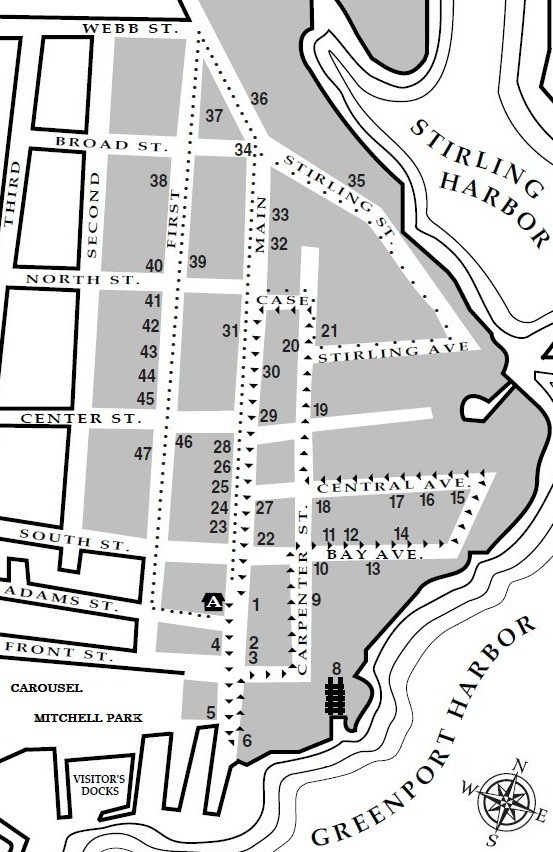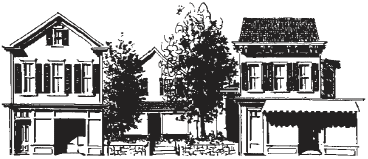Ireland House, 319 Main Street c. 1750s
On the north side of the village parking lot and north of the gazebo. Ireland House is the home of the Stirling Historical Society. The house was built in the early 1830s on the south side
of Adams Street about 100 feet from its present location. The house was home to numerous Greenport working families
many of whom rented from the property owners.
The house style is Greenport Vernacular, a common house form built from the 1750s. It is a simple small-scale half
house with a plain façade, painted clapboard, a doorway with sidelight and transom and 6/6 pane windows. It is a half
house because windows are on one side of the front door.
In 1973, Mr. and Mrs. Frederick Preston donated the house to the Stirling Historical Society and in 1976, the Society
moved it to the present location at 319 Main Street.
The Society named the house after Margaret E. Ireland, a well known civic worker and an admired, colorful resident of Greenport. She was a
newspaper correspondent for the NY Herald Tribune, the NY Journal American and local papers; a tireless fund raiser for Eastern Long Island Hospital
and Burton Potter Post American Legion, and matron of Greenport Police Department. Ms. Ireland's grandparents lived in the house in the late 1800s
and raised their family there. Later Ms. Ireland's parents, James and Margaret Grady, lived in the house and when Ms. Ireland returned to Greenport
in 1918, she also took up residency with her children. She lived in the house until her death in 1962 at the age of about-83. Because Ms. Ireland said,
"ladies never tell their age," the family cannot confirm her date of birth.
Photo
You have two walking options. Face east towards Bank of New York across the street and either A, walk down Main Street south toward the waterfront, circle around by way of Carpenter, Bay, Central and back onto Main, or B, walk north on Main to Memorial Park, left to First Street and then south on First back to the village. See map on back cover for routes.
#24.
The Times Building, 429 Main Street c. 1909
The name appears on the building frontage above the Ionic relief columns
that separate the multi-paned display window. This was the first
permanent office of The Suffolk Times, a weekly newspaper published
in Greenport from 1857 until 1989. The weekly continues to document
Greenport and Long Island's East End from its present office in
Mattituck.
Photo
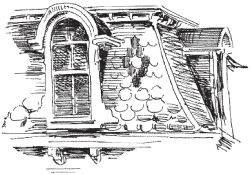
#25.
Phillips House, 433 Main Street c. 1830; rebuilt 1860
Named after S. W. Phillips, president of the
Peoples National Bank in the late 1880's,
the house is one of the most decorative buildings
in this sector. It has a scalloped slate
roof, massive decorative woodwork, heavily
bracketed mansard roof, and a carriageway
through south wing. A notable feature is the pair of white cast iron lions
straddling the front steps.
Photo
#26.
Timson Hotel, 437-455 Main Street c. 1830
The 3 1/2-story north section was the original construction with the 2-story
south wing added after 1890. The hotel was located at an important juncture
of Main and Central Avenue.
When the wharf at the foot of
Central Avenue was completed
in 1838, the hotel was in an
excellent location to receive
guests from the boats that docked at the wharf. It was also two blocks from
Stirling Hall (located at the southeast corner of Main and Bay) that provided
entertainment to guests and Greenporters until it burned in 1899.
Photo

#27.
Greenport Auditorium, 434 Main Street c. 1894
The Auditorium is a large, handsome and impressive Queen Anne structure
built through the "pluck and public spirit" of Miss Sara Adams to "uplift
the moral tone of the community." The architect was George H. Flack
and the builder was Charles Corwin. Until 1938, the Auditorium was the
center for cultural entertainment that included serious
drama, vaudeville and band music. Despite its current
use as a furniture store, the owners have preserved the
interior – its dressing rooms in the basement below
stage, the curved balcony with ornate metal grillwork
and the stage are in excellent condition.
Photo
#28.
H. E. Wells House, 455 Main Street c. 1873
This large Queen Anne house was built in front of a house built in the
early 19th century. The street frontage shows two bay windows and heavy
paneled doors with cast hardware. The façade has scalloped shingles, large
clapboards and a sunburst design at the peak of the roof. Mr. Wells, the
original owner, discovered the bunker process of extracting fish oil.
Photo
#29.
500 Main Street c. 1858
The house marks a border between the commercial developments on
lower Main Street near the wharfs and the residences built primarily for
merchants to the north. Built in Greek Revival style, a distinguishing
feature of the property is the two-story porch that was added between
1890 and 1897. The porch has four 8-sided columns topped by double
brackets and 4/4 porch windows that extend to the porch floor.
Photo
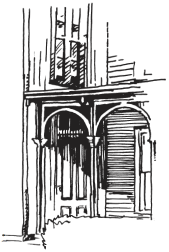
#30.
Captain Wells House, 530 Main Street c. 1864/70
Italianate villa of grand proportions built for Captain
Wells at the height of the whaling industry. The house
has twin-arched windows on all sides of the tower and
elegant arches on front porch. After losing his whaling
fortune, Captain Wells had his ship, the Swallow, enlarged
and went to Africa to obtain slaves. He collected the human
cargo and started homeward but was never heard of
again. The crew, however, arrived safely, sold the slaves and the ship.
Photo
#31.
Captain Case House, 527 Main Street c. 1850/70
Ebenezer W. Case lived here through the above period. The 2 1/2-story
house with mansard roof, embellished in 1870, is vintage Victorian. It
is bracketed French Second Empire style with side bay window, jigsaw
porch detail, dentils under window caps and a double front door.
Photo
#32.
Grosvenor C. Adams House,
630 Main Street c. 1870
Mr. Adams was the president of the First National Bank from 1864 when
the bank was chartered until his death in 1883. The house is Queen Anne
style with inverted truncated shingles on gable pediments. Bracketed cornice,
double front door with round head; 2-story south bay with paneled
dado. Notable entablatures on rear porch door and windows.
Photo
#33.
Conklin House, 636 Main Street c. 1820
This Greek Revival house was built for the Conklins by Orin Wiggins and
is one of the older structures in this area of Main Street. It is a 1 1/2-story
cottage with a hand-constructed window and door cornices. Much of
the original detail is intact.
Photo
#34.
Civil War Monument,
Broad and Main Streets 1883
"The community is indebted to the energetic work of the ladies of the
Soldiers Aid Society" for the Soldiers Monument and were assisted by
comrades of the Edward Huntting Post II G.A.R. Beginning with a
Fourth of July benefit dinner, the ladies of the Soldiers Aid Society raised
the funds ($1,000) for the monument. The Quincy granite monument
is a tribute to the death of 29 Greenporters. It was installed in November
1883 and dedicated on Decoration Day 1884.
Photo
In early years, the convergence of Main, Broad and
Stirling Streets was called Steamboat Corner and led
to the docks in Stirling Harbor. People gathered here
to watch the boats in the harbor and share tales of
sea adventures.
You have the option of walking along Stirling Street to house #35 and
then on to views of the marinas of Stirling Harbor where Greenport
was first settled. Stirling Street/Avenue links back to Carpenter Street
at #20 on Tour A. (see second option below)
#35.
162 Stirling Street c. 1883
This prominent waterfront site was the location of the T. Hempstead
pottery prior to the construction of the house by Mr. Beck, president
of N.Y.C. Fire Insurance Co. The house, set on spacious grounds, has
several unique features some of which were added in 1908: Palladian
style window in the front gable; wood fanlight carving in gable tip; scalloped
shingles with finial-like ornaments; double front doors with large
beveled glass windows and a turret.
Photo
OR... continue on Tour B north along Main Street to Memorial Park and then south on First Street where you find many fine examples of late 19th century residences.
#36.
Townsend Manor Inn c. 1835, 1858
(a) 714 Main Street 1835
One of three buildings comprising the inn property. The highly visible
house, residence of whaling Captain George Coggswell, has a two-storied
columned façade with dominant exterior moldings. The property backs onto
Stirling Creek thereby providing boat dockage. Captain Coggswell moved to
California in 1849 though Widow Coggswell was in residence in 1858.
(b) 726 Main Street c. pre 1858
Architecturally, the Gingerbread House represents a highly individualistic
handling of Italian elements by an unknown architect. Its elaborate cornice
has large and small fleur-de-lis motifs. The front door transom and
sidelights have very rare, original, stained dark red and blue windows
with cutout, stencil type designs. In 1858, the house was the residence
of G. Cripps.
Photos
#37.
Memorial Park,
Main and First Streets
The small triangular park is located where First and Main Streets converge.
The park has three monuments dedicated to the memory of Greenporters
who served in the U.S. military in World War I, World War II or the
Vietnam Conflict.
Photo
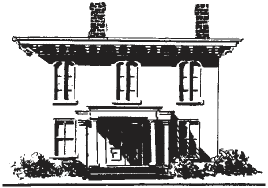
#38.
633 First Street c. 1870
The house was the 1873
residence of G. H. Cleaves, a druggist who worked for G. H. Corwin.
It is a large two-story Italianate with flat
roof. The exterior and interior are rich
in late 19th Century detail. Exterior has
paneled fascia board with double solid
ribbon brackets. A side porch was added
in 1897 and extended prior to 1909.
Photo
#39.
602 First Street c. 1850
This fine example of Italianate style was built in 1850. The second-story
arched window carry upward the effect achieved by the arched front door
with its etched ruby glass sidelights. Brackets and all exterior woodwork
are well proportioned and executed. Note the finely detailed half octagonal
bay window on the south elevation. Between 1897 and 1909, the cupola
was removed and the roof changed from slate to shingle.
Photo
#40.
603 First Street c. 1847
In the 1850s, Captain Tyler owned the house. One of the few brick
buildings in the village, this residence is an excellent example of Federal
style with elegant Greek Revival elements. The columned portico doorways
are outlined by narrow sidelights and transom and dentils under
the eaves. Note the balance achieved by the matching entries facing the
two corner streets.
Photo
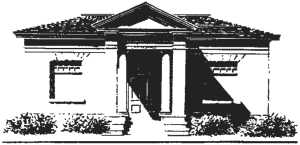
#41.
Floyd Memorial Library, 110 North Street 1917
The funds ($30,000) to construct the library were donated by Miss Grace
Floyd in memory of her father, David Gelston Floyd, a whaler, banker
and grandson of General William Floyd signer of the Declaration of Independence.
The library was designed to resemble the Floyd homestead,
Brecknock Hall on Sound Avenue, and the stones
came from the estate's quarry. D. Stanley Corwin
completed the construction in 13 months.
In 1998, the 3-story west wing more than doubled
the size of the library.
Photo
#42.
529 First Street c. 1874
An inscription on the basement wall dates the house June 1874 for the
owners named Hubbard. An extremely fine building set farther back
from First Street like its neighbors at 519 and 525. It has a distinctive
Mansard style with Italianate details that include fine bracketing, window
caps over second-story dormers and scrollwork under eaves.
Photo
#43.
Andrew Wiggins House, 519 First Street c. 1858
This house, a conglomeration of Italianate and Mansard styles, contains
some of the finest exterior trim and features found in the area. The
exceptional workmanship is by Andrew Wiggins, carpenter, who built
the house for his own family. Elaborate bracketing, dentil work, arched
window caps and paneling are visible on the front of the house. Look
toward the back of the left side of the house to see a continuation of the
beautiful woodwork on the side porch.
Photo
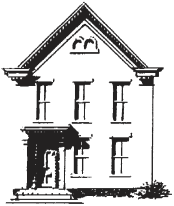
#44.
Whitney Hubbard House, 511 First Street c. 1858/73
Late Greek Revival doorway with interesting
turned trim on door pilaster. Note dentils
under roof eaves and door cap, and double
arched windows in gable. Whitney Hubbard,
notable Long Island Impressionist
painter, inherited the house from his father,
Elijah, a confectioner. The family retained
ownership from 1880 to 1965. Whitney's
studio was on Main Street.
Photo

#45.
Ackley House, 509 First Street c. 1845
Ackley House is one of two brick residences (the other is #40) in Greenport.
Its style is Federal while the entry
door trim and sidelights are Greek
Revival. Note the elegance achieved by
the row of windows on the second story
and the attractive dentils at roofline
and around door portico. There has
been very little change in the exterior
and interior.
Photo
#46.
William Corey House, 440 First Street c. 1882
Small village estate built by William D. Corey of Webb and Corey, a
major port chandlery. The house's roof is slate with a Victorian cast iron roof railing outside the third story. The façade has scalloped shingles
and decorative brackets. An Ionic-columned porch wraps the front
and south side of the house providing access to the Colonial doorway
with arched transom and sidelights. When built, it was reported to
be "one of the handsomest places in Greenport – everything about it
is as neat as a pin."
Photo
#47.
Hartley House, 437 First Street c. 1882
This is a late 19th century, 2 1/2-story cross-gabled house with fine decorative
woodwork on the porch and in gables. Most windows have pediment
molding; small cathedral windows in each of the four gables. The house
was the residence of Charles W. Hartley, a harness maker who in the
1880s located his business near 1st and Front Streets.
Photo
Tour B ends here. Return to Ireland House by walking east through the village parking area.
 B
B 

 B
B 

